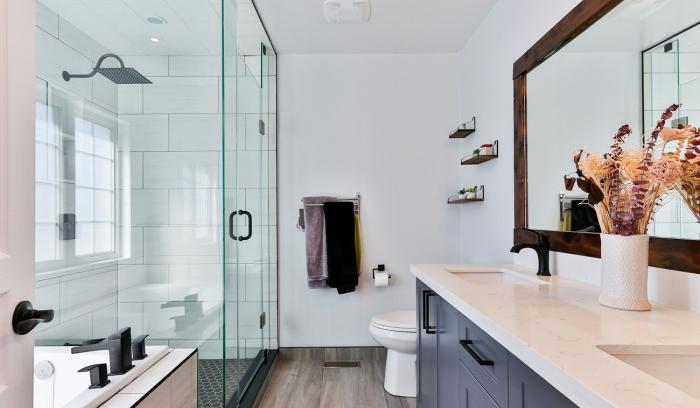When it comes to home upgrades that instantly elevate both style and functionality, a bathroom vanity tops the list. Whether you’re remodeling your master bath or refreshing a guest powder room, the right vanity transforms the entire space.
In this guide, we’ll break down everything you need to know about choosing the perfect bathroom vanity—from sizing and storage to materials and aesthetics—so you can make the best choice for your home.
Why the Bathroom Vanity Matters
Your vanity is more than just a sink—it’s the anchor of your bathroom. It influences your layout, storage capacity, and the overall vibe of your space. A well-chosen vanity can:
- Provide essential storage
- Maximize space in small bathrooms
- Enhance design aesthetics
- Add resale value to your home
Step 1: Measure Your Space Like a Pro
Before falling in love with a vanity design, you need to know what will actually fit. Here’s how to do it right:
- Take accurate measurements:
- Width (side to side)
- Depth (front to back)
- Height (floor to top of vanity)
- Clearance for door swing and drawers
- Consider plumbing location:
If you’re not planning to move plumbing, choose a vanity that aligns with your existing setup. - Allow for traffic flow:
Ensure there’s enough room to move comfortably, especially in shared bathrooms.
Step 2: Choose a Vanity Size That Fits Your Lifestyle
Single vs. Double Sink
- Single Sink Vanity: Ideal for powder rooms or bathrooms with limited space.
- Double Sink Vanity: Perfect for shared bathrooms, allowing two users to prep simultaneously—just like the Sonoma 72" Double Sink Vanity, which accommodates busy mornings with ease.
Standard Vanity Sizes
|
Size (Width) |
Best For |
|
24" - 36" |
Small powder rooms |
|
36" - 48" |
Guest bathrooms |
|
60" - 72" |
Master bathrooms |
Step 3: Select a Vanity Style That Reflects You
Popular Bathroom Vanity Styles
- Modern Minimalist: Sleek lines, handleless drawers, neutral colors.
- Rustic Farmhouse: Reclaimed wood, matte finishes, bronze hardware.
- Traditional Elegance: Detailed moldings, rich wood tones, classic designs.
- Transitional: A balanced blend of old and new elements.
✨ Pro Tip: A solid teak wood vanity like the Sonoma adds warmth and natural charm to both contemporary and traditional settings.
Step 4: Decide on Vanity Top and Sink Options
Countertop Materials
- Quartz: Durable and non-porous, resistant to stains and scratches.
- Marble: Elegant but requires more upkeep.
- Granite: Natural beauty with high durability.
- Solid Surface: Seamless look, easy to clean.
Sink Types
- Undermount: Sleek and modern with easy counter cleanup.
- Vessel: Bold statement style, sits on top of the counter.
- Integrated: Sink and counter are a single piece—great for minimal maintenance.
Step 5: Focus on Storage That Works
Think beyond aesthetics—functionality matters!
- Drawers vs. Cabinets: Drawers offer better organization; cabinets offer more bulk storage.
- Shelving: Great for decorative storage (think towels, candles, baskets).
- Built-in Organizers: Prevent clutter and keep essentials within reach.
???? Look for soft-close hardware and full-extension drawers for daily convenience.
Step 6: Pick the Right Finish and Hardware
Even small details like handles and faucet finishes can impact your bathroom’s final look.
Finish Options
- Natural wood for warmth and texture
- Painted finishes like white, gray, or navy for a crisp, clean feel
- Matte black or brushed gold for modern flair
Hardware Choices
- Bar pulls for contemporary appeal
- Knobs for a traditional look
- Mixed metals for a custom vibe
Step 7: Lighting and Mirror Pairings
Don’t overlook the importance of good lighting and a mirror that complements your vanity.
- Wall-mounted sconces on either side of the mirror prevent shadows.
- LED-backlit mirrors offer a sleek, modern look.
- Framed mirrors add character to rustic or classic designs.
Step 8: Installation Tips
While many vanities are DIY-friendly, some situations call for professional help—especially when moving plumbing or installing double sinks.
- Ensure level placement
- Secure to wall studs
- Seal around the sink to prevent water damage
????️ When in doubt, hire a licensed contractor to ensure a watertight, code-compliant installation.
Conclusion: A Bathroom Vanity Is an Investment in Style and Function
Choosing the right bathroom vanity isn’t just about filling a space—it’s about creating a beautiful, organized, and practical room you’ll enjoy every day. Whether you prefer something modern and sleek or warm and natural like the Sonoma Double Sink Vanity, investing in quality makes all the difference.
FAQs About Bathroom Vanities
1. What is the standard height for a bathroom vanity?
The standard height is around 32 to 36 inches. Comfort-height vanities are closer to 36 inches and are often preferred in master baths.
2. Can I install a bathroom vanity myself?
Yes, if you're comfortable with basic plumbing and carpentry. However, hiring a pro is advisable for complex setups or double sinks.
3. What’s the best material for a bathroom vanity?
Solid wood, especially teak, is highly durable and resistant to moisture. Other good options include MDF (with proper sealing), plywood, and metal.
4. What type of vanity is best for a small bathroom?
A wall-mounted or narrow-profile vanity helps save floor space while maintaining function and style.
5. How do I maintain my bathroom vanity?
Regularly wipe down surfaces with a damp cloth, avoid harsh cleaners, and use trays or organizers to minimize clutter and protect finishes.
6. Do I need a backsplash with my vanity?
While not mandatory, a backsplash can protect your walls from moisture damage and add a polished look.
7. What’s the benefit of a double sink vanity?
It allows two people to use the bathroom simultaneously—ideal for couples or families. It also offers more counter space and storage.
Let your bathroom be more than just functional—make it a stylish retreat. Ready to upgrade? Explore the beautifully crafted Sonoma Solid Teak Double Sink Vanity and discover how easy it is to combine elegance with practicality.






